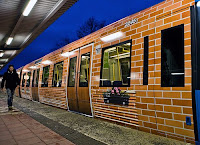 If you’ve ever taken the shuttle train from Times Square to Grand Central Station in New York City, you’ve undoubtedly encountered one of those ads that cover every inch of the inside of the train, from the ceiling to the seats to the floor. It’s striking, effective and inescapable. Well, the MTA is going to new lengths to sell ad space and marketing execs are thinking outside the box (or train) in trying to find new ways to reach potential customers. The other night, while waiting for the subway, a train went whizzing by with banner advertisements plastered onto the exterior of each car.
If you’ve ever taken the shuttle train from Times Square to Grand Central Station in New York City, you’ve undoubtedly encountered one of those ads that cover every inch of the inside of the train, from the ceiling to the seats to the floor. It’s striking, effective and inescapable. Well, the MTA is going to new lengths to sell ad space and marketing execs are thinking outside the box (or train) in trying to find new ways to reach potential customers. The other night, while waiting for the subway, a train went whizzing by with banner advertisements plastered onto the exterior of each car.
In this economy, you’d think that there would be plenty of ad space on subway platform walls or inside the train, or that companies would cut their advertising budgets significantly. But maybe the MTA is on to something: By offering new and unique avenues to reach consumers, they’re making it more appealing for advertisers while increasing their own revenue (a good thing for New York subway riders who don’t want to see another obscene fare-hike). A recent Forbes piece is even urging companies not to give into the temptation to skimp on their ad budgets during these troubled economic times because that could allow for competitors to make inroads; instead, they say, that “the key is to craft messages that reflect the times and describe how their product or service benefits the consumer.”
The risk, of course, is that the kind of visual assault that the MTA is offering could backfire. Devising clever ways of reaching consumers is almost always a good thing, but people don’t like being force-fed. An article in Advertising Age last week pointed to consumers who are taking action against ubiquitous advertising, like Toyota’s “Saved by Zero” television commercial, which ran almost on a loop nationally and which inspired a Facebook group in an effort to stop it. In a troubled economy, and in branding in general, balance is key.
Advertising Age, Forbes, MTA, recessions, Saved by Zero, subway, Toyota





{ Comments are closed! }